
Image Source: Pinterest.com
Punjabis are simple yet fun-loving people who believe in expressing their emotion with gusto. Similar to their nature, their weddings reflect their life philosophy. Punjabi weddings are colorful, loud, sometimes over the top, fun filled with lots of opportunities for singing and dancing one’s heart out. Punjabi weddings may be simple or lavish, but they ensure unlimited fun and celebration. A host of pre and post wedding rituals make a Punjabi wedding a lengthy and enjoyable affair. Although, Punjabis do not miss an opportunity to make merry, their weddings display their propensity towards adhering to age old traditions, albeit with a conventional twist to them sometimes. From elaborate lehengas to the noisy baratis, the ‘dance till you drop’ Sangeet to the extremely friendly and warmly-welcoming host, a Punjabi wedding is akin to a true roller-coaster. Let’s take a look at the various wedding Rituals.
Pre-wedding Rituals
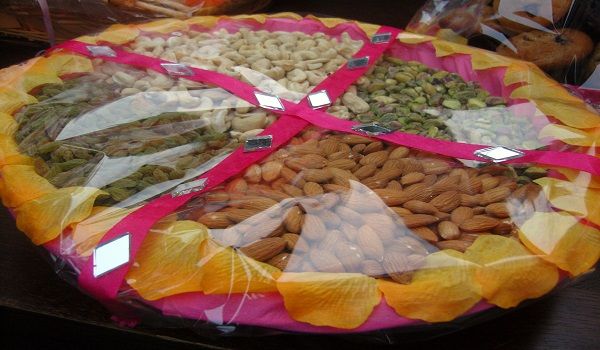
Roka and Thaka – When all aspect of the marriage looks satisfactory the bride’s family visits the groom’s place to offer the groom their blessing along with various gifts for the family like fruits, sweets, clothes, money also known as shagun etc. This custom is known as the Roka. The bride is generally not present at the Roka. The groom’s family reciprocates the gesture by visiting the bride’s family on a separate day carrying gifts. The return ceremony is known as Thaka. These two are generally low key affairs with only the close family attending it. The Roka ceremony marks the beginning of relationship between the two families and usually begins with a small puja called Ardaas.
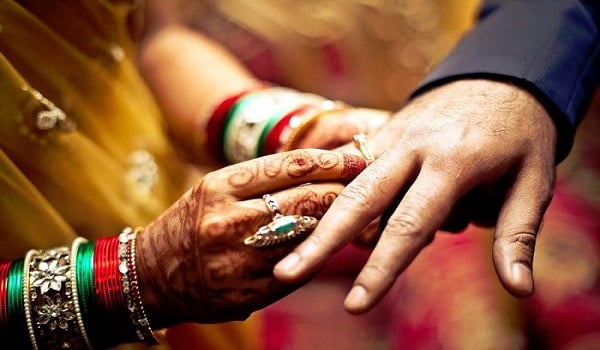
Image Credit: sriradhacaterers.com
Mangni/Sagai– This ceremony marks the official engagement between the couple. This is often a grand ceremony and precedes the wedding by some months at least. Family and friends gather from both the bride’s and the groom’s sides. The bride is fed boiled rice and milk by the groom's family. Amidst a celebratory mood the couple exchanges rings. The sagai ceremony makes the match an official one.
Shagun and Chunni Chadai – To mark the acceptance of the bride into the groom’s family, the Chunni Ceremony is observed. A group of ladies arrive at the bride’s house on the morning of the Sagai or a day before. They bring with them the outfit that the bride is to wear for the Sagai along with jewelry, sweets, fruit, mawa etc. Special part of the gift is an intricately embellished head scarf or Chunni. The Chunni is placed on the bride’s head and her face is covered with it like a veil. This ceremony is known as Chunni Chadana. She is then gifted jewelry like bangles or necklaces that are family heirlooms by her mother-in-law who helps her put them on. A tiny dot of henna is applied on her palm to mark the ceremony auspicious. These gifts to the bride are known as Shagun.
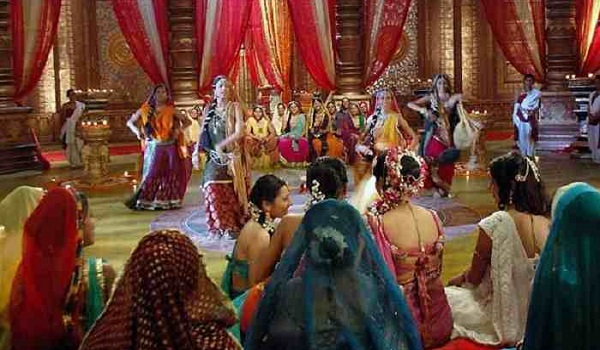
Sangeet – The Sangeet is a musical party generally arranged by the bride’s family. Traditionally, the ladies of the family got together and sat surrounding the bride. Together they made merry by singing folk wedding songs, teasing the bride, and dancing. The groom and a few of his family members were also invited to participate. Nowadays, the sangeet is a gala event when both the families get together to enjoy a fun-filled musical evening. Groups from both sides present dance performances that are often choreographed by experts. It’s basically a great opportunity for the families to get acquainted with each other.
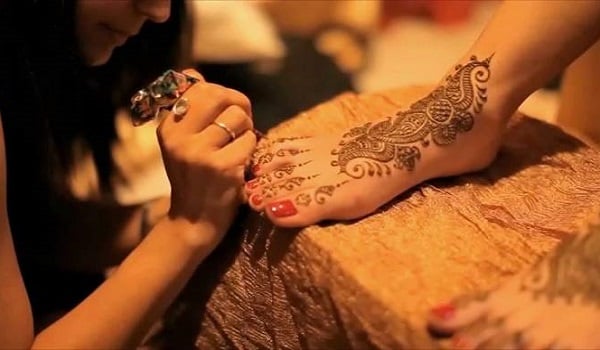
Image Credit: YouTube
Mehendi – Mehendi is an indispensible part of Punjabi wedding ceremony. The bride sits down on a special stool and henna paste is applied to her hands and feet. The henna designs are intricate and elaborate, and the groom’s initials are hidden amidst the various patterns. Upon drying gives a dark red color. It is believed the darker the color of the mehendi is, the more love the bride will receive at her in-laws. Previously, family members used to apply the henna paste but nowadays professional mehendi artists are hired. Other female members of the family also get henna applied to their hands. At the groom’s place the same mehendi ceremony is observed but at a smaller scale. Generally, a very simple henna design is applied to the groom’s palms. Traditional wedding songs are sung during the whole ceremony.
Wedding Attires
The Punjabi groom traditionally wears a set of Kurta Pajama to the wedding. The Kurtas may also be paired with churidar trousers. The designs on these Kurtas are generally lavish and elaborate. Nowadays, as a standard the Punjabi groom wears Sherwani. Cream or off-white is the preferred colors with lots of embellishments with zari threadwork, beadwork and stone decoration. He pairs the sherwani with a pajama or churidar in a complementary color like blue or maroon. He also wears a dupatta around his neck. He wears a traditional jooti or more modern loafers with the whole outfit. He wears a headdress with dangling strands of either flowers or decorative ribbons and even strings of pearls that cover his face. This special headdress is known as Sehra. The top part of the sehra is attached around the groom’s forehead and tied behind his head.
The Punjabi bride is a sight to behold. Resplendent in a gorgeous lehenga and lots of fashionable jewelry, she walks in beauty. Punjabi brides are very picky when it comes to their wedding lehenga and love to go all the way for the perfect one. Although Red is the traditional wedding color for all Indian brides, Punjabi brides are known to go for other colors like green, gold, fuchsia and orange. She pairs the lehenga with a matching dupatta with which she covers her head. She wears a lot of jewelry, some of it made of gold while some of it may be modern costume jewelry. Some compulsory components are maangtika, bangles, Nath, Chooda (a traditional red and ivory colored bangle set in multiples of four), kamarbandh and Paijaniya. The sister-in-law of the bride ties a set of Kalire to her wrists. These are gold or silver ornaments that are dome shaped with multiple danglers attached to them.
Wedding Day Rituals
Jago – The night before the wedding, the family stays up till late at night and Jago is celebrated at wee hours of the morning. A brass or copper Khada is decorated with clay lamps. The maternal aunt or mami of the bride/groom carries the vessel on her head while another lady will try and shake it with a long stick having bells attached. The ladies sing Punjabi wedding songs and will visit houses of friends and relatives who feed them sweets. They then dance together before moving on to the next house.
Gana Bandhna – On the morning of the wedding day, at their respective houses, the bride and the groom attend a puja. After completion of the puja the priest ties a sacred thread or mouli to their right wrists. The mouli is tied around a betel nut and a shell known as Kaudi. It is knotted multiple times around the wrists to make it difficult to untie later.
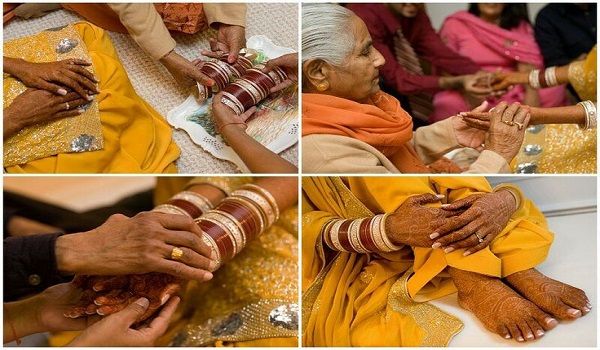
Chooda Chadana – Chooda refers to a set of red and ivory bangles generally in a set of multiples of four. The eldest maternal uncle of the bride has a vital role to play in this ceremony. The maternal uncle or mama sits for a havan during which the chooda are purified in liquid mixture containing milk and rose petals. The head and face of the bride is covered during the ceremony as she is not supposed to see the chooda until the moment of her wedding. The maternal uncle and his wife then slip the Chooda into the bride’s hands. Other elderly members touch the chooda and give their blessings. Flower petals are showered on the bride. She is also gifted her wedding Lehenga by her maternal uncle at this time. The sister-in-law, friends and sisters of the bride then ties in the Kalire around her wrist or to one of her bangles which are umbrella-shaped ornaments that are often encrusted with coconut, dry fruits or dried betel nuts.
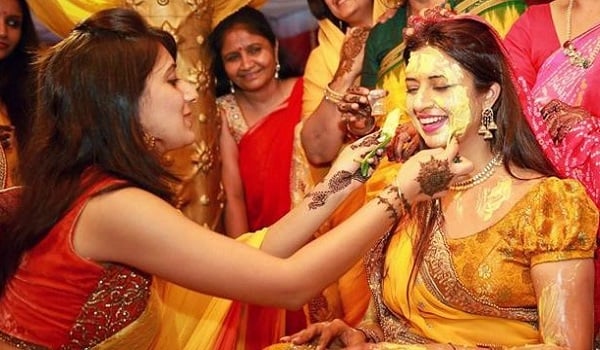
Image Source: dnaindia.com
Haldi – Four lamps or diyas are lit and the bride sits on a low wooden stool facing them. A paste made up of sandalwood, turmeric, rosewater and mustard oil is prepared. This paste is applied all over the bride’s body especially face, hands and feet by the married ladies of the family. It is believed that the radiance from the diyas will impart an everlasting glow on the bride’s face. A similar ceremony is also observed at the groom’s house. The family members anoint each other with the same paste and there prevails an atmosphere of happiness and gaiety.
Ghara Gharoli – After completion of the Haldi ceremony, the dried haldi paste is scrubbed off from the bride’s face and body. She is then taken to a nearby temple where she is bather with pitchers full of holy water. This ritual is known as Ghara Gharoli. She then performs a prayer to the deity of the temple asking for blessings. She returns to her home and takes a proper shower and starts getting ready in her wedding finery. The same ritual is also observed by the groom’s side.
Sarbala – Sarbala refers to the caretaker of the groom. Generally a kid member of the family is chosen for this part and dons clothes similar to the groom. He then accompanies the groom to the wedding.
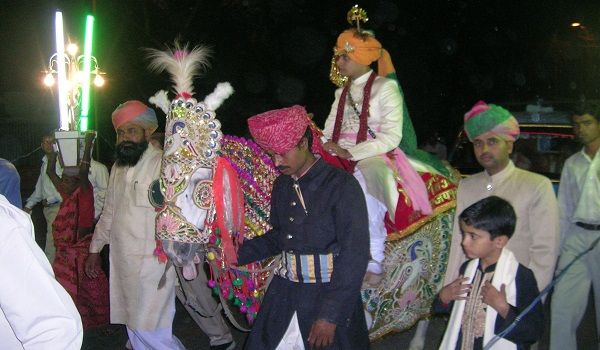
Sehrabandi and Varna – The groom dresses up in his wedding sherwani and churidar. A small puja is then performed in his honor. The turban and the Sehra is sanctified by the priest during this puja. The turban and the Sehraare tied around the head of the groom by an elder male member of the family or the groom’s brother-in-law.
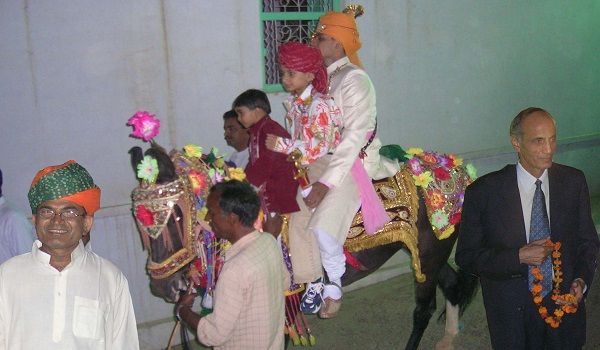
Image Source: Wikipedia.org
Ghodi Charna – Traditionally, the Punjabi groom sets off for the wedding venue by riding a mare. The mare is decked up in gaudy decorations and tika is applied on its head. The mare is also fed chana dal (lentil) and water by the female relatives of the groom. The groom’s sister-in-law then applies surma to the groom’s eyes to ward off evil vibes. The groom them mounts the mare in a ceremonial manner. He is then accompanied by members of his family who sets off for the wedding venue along with him. The wedding procession is accompanied by a band that plays peppy musing and the members of the wedding procession dance to it.
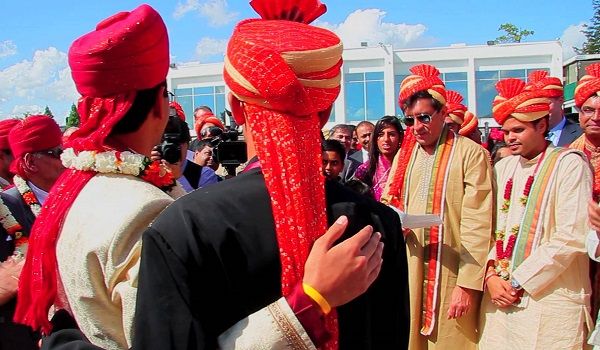
Image Source: YouTube.com
Agwaani and Milni – The groom along with the wedding procession arrives at the wedding venue. They are met at the entrance by the bridal party. The love and warmth that Punjabis are well-known for is very apparent during this moment where the two families smile and embrace each other. This ritual when the groom and his family arrive at the wedding venue is known as Agwaani. The groom is then welcomed by the mother of the bride with a traditional arti and tika on the forehead.
The relatives of the groom then are sought out by the corresponding relative from the bride’s side, eg. Maternal uncles of the groom are sought out by maternal uncles of the bride. They greet each other and are welcomed inside the venue. This ritual is known as Milni.
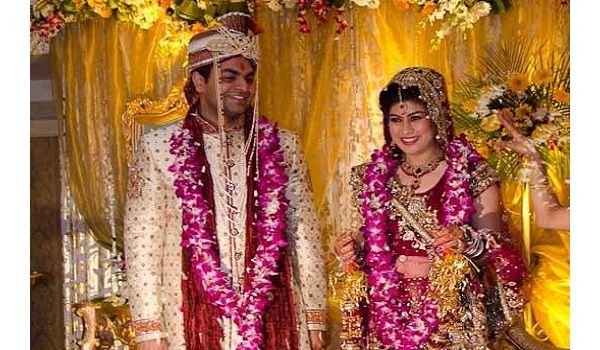
Varmala– On entering the wedding hall, the groom is led towards the stage and he is made to stand upon a small pedestal. At the designated muhurat the bride arrives at the stage and the couple exchange garlands. This is a fun-filled ceremony where there is competition among the two sides to lift either the bride or the groom higher so that the other cannot put the garland over his or her head.
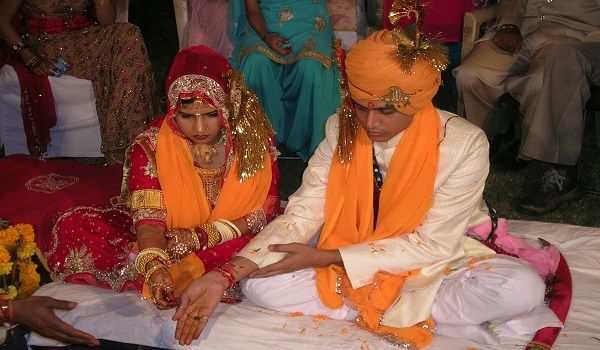
Image Source: Wikipedia.org
Madhuperk– The bride and groom then proceed to the wedding mandap and the groom is offered a small bowl of water that he has to drink. He sprinkles some on his feet and drinks the rest. He is then offered a special concoction made with curd, honey, milk, ghee and other sacred essences. This is known as the Madhuperk. The groom is to take a sip off this drink before the wedding rituals commence.
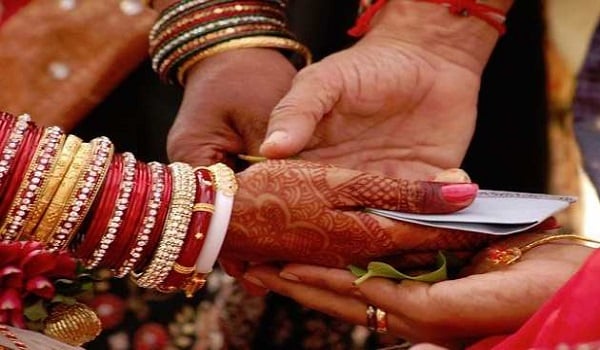
Image Credit: https://kanyadaan.files.wordpress.com/2010/03/manas_kanyadaan.jpg
Kanyadaan – During this age old Vedic ritual, the bride is given away by his parents to the groom. He requests the groom through Vedic mantras to take good care of his daughter and the groom accepts the bride’s hand and promises her father that he will treat her with utmost love and respect throughout his life.
The wedding havan is lit which is the sacred fire. In Hindu custom, the fire deity is the foremost witness of a wedding. The groom is handed over a plate which has fourteen parallel lines drawn on a bed of flour with a flower. The lines symbolize fourteen vows of a marriage. The priest outlines these vows one by one through Vedic mantras; the groom repeats after him and erases one line with a flower bud.
Phere– Next, the couple gets up. Then ends of their dupattas are tied in a knot and they encircle the sacred fire four times. For the first three times, the bride precedes the groom and for the final phera she has to follow the groom.
Lajahom– For this ritual, the bride’s brother pours puffed rice into her cupped hands. The bride and the groom then offer this to the fire together and seek the Fire God’s blessings. This ritual is repeated thrice.
Sindoor Daan– After completion of the Lajahom, the groom applies sindoor to the bride’s hair parting and ties the Mangalsutra around her neck. This completes the wedding rituals.
Joota Chhupai – While the groom is busy in the wedding, the bride’s sisters take hold of his shoes and hide them. When the wedding is complete and the groom steps out of the wedding mandap, they demand a ransom for returning the shoes. There is a lot of bargaining involved between the two parties and they come to an agreement. The groom has to pay the agreed upon amount in order to get back his shoes and move from the mandap.
Post-wedding Rituals
Vidaai/Doli – The bride bids a tearful goodbye to her family and throws handful of rice over her shoulder’s in her family’s direction. This way she expresses her gratitude towards them for taking care of her for so long. She is then sent off in a decorated car to her husband’s home. This return bridal procession is known as Doli.
Paani Bharna – On arrival of the Doli, the mother of the groom does an arti of the bride with a pitcher of water. After each circle, the mother-in-law attempts to take a sip of water, but the bride prevent her from drinking. She finally relents after the seventh circle. She then crosses the threshold after overturning a pot of rice with her right feet.
Mooh Dikhai – The couple is then taken to seek the blessings of the family deity. Next, the bride is seated and her veil is lifted for all of family and friends to see. The elders of the family then shower their blessings on the bride and give her gifts of cash and jewelry.
Reception – A lavish reception party is thrown by the groom’s family in honor of the newlyweds. A Punjabi reception is an occasion of immense joy with scrumptious meals and high-spirited music.
Pag Phera– The bride returns to her parent’s home with her husband. The parents welcome their daughter and son-in-law with a grand lunch. The couple has to spend the night at her parent’s place. The next day she returns to her husband’s home with a lot of gifts for her in-laws. This marks the end of the wedding celebrations.




